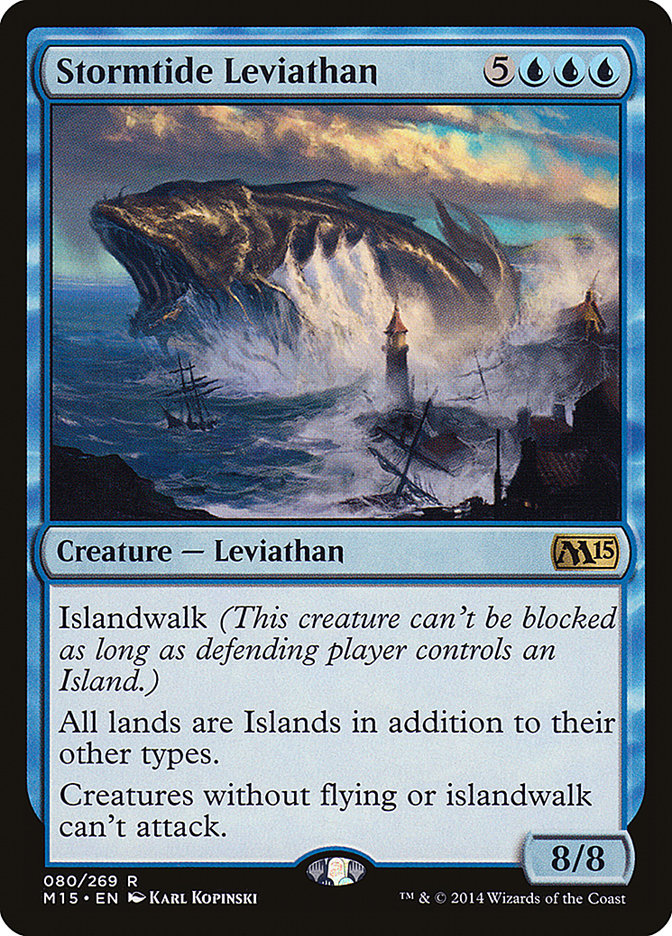The Mutual Constitution of Mechanics and Diegesis: The Example of “Stormtide Leviathan”
While it is not necessarily interesting nor relevant to ask which comes first in the process of invention, it is important to recognize that each card in Magic combines both a unique set of game mechanics and an appropriate representation in the diegetic game world. First, each card serves as a representation of a creature, spell, object, or event in the fictional game world where the Planeswalkers (those who walk between magical realities, and the players controlling them) do battle. Second, each card contains a particular collection of potential actions to be taken by the players. These two elements are mutually constitutive—distinguishable but inseparable. However, the mechanic-diegetic relationship of the cards is not one of random chance or oppositional tension, but one that is mutually beneficial. For example, consider Stormtide Leviathan from the 2015 starter deck Hit the Ground Running.
Here we can see productive and aesthetic elements of the text work together. Some of the mechanic-diegetic co-constitution may be obvious; aquatic life is a major aspect of the water-affiliated Blue creature base (squids, merpeople, seabirds, and other sea-monsters), complemented by the Blue mana resource, the Island. The Stormtide Leviathan is quite large, represented by its high power and toughness (8/8), and its high casting cost means it will appear quite late in any given game. It is a finisher whose appearance is likely to weaken or destroy opposing creatures and end a game quickly. Also, summoning such a large creature would require a large amount of mana, in terms of both the diegetic explanation and the appropriateness of the mechanical costs for playing the card, so the one playing it much have ample resources and the appropriate army. In this way, a big fish is an appropriate and fitting finish for a player with Blue deck. However, this creature’s three abilities make this not only an intimidating creature but an especially powerful late game spell. Every card, except a Land, is a Spell card; these too are mutually constitutive; ebb and flow.
Its first ability, Islandwalk, emphasizes this creature as a deadly sea monster and dangerous to shore-dwellers, but can also be limiting in many cases, since the mechanic requires the opponent to also use Islands for the creature and player to fully benefit. Since not all players may use Islands, this walk ability and its corollaries (e.g. Swampwalk) have been seen as a disadvantage by players and general phased out in subsequent releases. Diegetically, even a very big fish out of water would be little threat, but this fish brings the water with it.
The second ability transforms all lands into Islands in addition to their other types, which therefore renders the limitations of Islandwalk moot. Upon entering the battlefield, the Stormtide Leviathan brings the stormtide and drowns all lands into Islands. We can see this in the illustration; the beast rampages, dwarfing the lighthouse and drenching the cliffs around. While Mountains still tower and Forests still bloom, there are all flooded Islands as well. This combination of mechanics make this Leviathan unstoppable from the first time it attacks.
The third ability further enacts this catastrophic change to the diegetic topography. By preventing creatures without flying or islandwalk from attacking, this creature not only makes itself more effective, but makes any opponent’s creatures less effective, struggling to swim, keeping their head above water, whether goblins, skeletons, knights, or baloths. Following the deluge caused by this creature, only those creatures who are themselves aquatic or able to fly above the flood can be effective—they would otherwise have been drenched and drowned in the Leviathan’s wake.
The three mechanics, as well as the cost, color, and type, of Stormtide Leviathan all perform the diegetic reality of this creature as an animate natural disaster, and the accompanying catastrophe caused when this creature is summoned produce a coherent center through which the mechanics function together. These three abilities, beyond the creature itself, are examples of typical Blue Control strategies, which emphasize the manipulation of the game mechanics rather than direct diegetic confrontation, attacking an opponent with creatures or blasting them with lightning. In short, the procedure creates the representation and the representation coheres the procedure. Coherence creates coherence.
